Benchmarking Physical Model Experiments with Numerical Simulations for the Wangjiashan Landslide-Induced Surge Waves in the Baihetan Reservoir Area
Abstract
:1. Introduction
2. Overview of the WJS Landslide
3. Physical Model Experiment of WJS Landslide-Induced Surge Waves
3.1. Establishment of the Physical Model
3.2. Experimental Monitoring System and Equipment
3.3. Analysis of Experimental Scale Effects
3.4. Experimental Analysis
4. Numerical Simulation of Landslide-Induced Surge Waves Based on Fluid Dynamics
Numerical Simulation Elucidates the Formation and Propagation of Landslide-Induced Surge Waves
5. Benchmarking Physical Model Experiments Using Numerical Simulations
5.1. Comparison and Analysis of Wave Generation Zones
5.2. Comparison and Analysis of Wave Propagation Areas
5.3. Comparison and Analysis of Wave Run-Up in the Residential Area
5.4. Comparison and Analysis of Wave Height and Run-Up Values
6. Discussion
- (1)
- Method Comparison. This study used physical model experiments and numerical simulations to investigate the dynamic characteristics of landslide-induced surge waves through benchmark testing. Each method has its unique advantages and limitations, contributing to the overall understanding of the phenomenon. Physical model experiments are characterized by high precision and direct observation. They can accurately reproduce the complex interactions between landslide materials and water, capturing detailed phenomena such as splash formation and wave breaking. Researchers can directly observe physical processes and collect empirical data, providing a solid foundation for validating numerical models. However, physical model experiments have scale effects, and some physical phenomena (surface tension and viscosity effects) may not be perfectly replicated. High time and cost constraints limit the number of testable scenarios. Numerical simulation methods offer high flexibility, efficiency, and detailed analysis capabilities. However, numerical simulations rely on various assumptions and simplifications (grid resolution and boundary conditions), which may introduce errors. High-resolution simulations require substantial computational resources, which can be a limiting factor.
- (2)
- Complexity of Geological Conditions. The geological conditions at the WJS landslide site are particularly complex, posing challenges for both physical and numerical modeling. The WJS landslide is composed of a mixture of mud, silt, gravel, and clay, with a fractured bedrock base. This heterogeneity affects the landslide behavior and the generation of surge waves. The steep and variable terrain of the reservoir area, including sharp elevation changes and irregular channel shapes, significantly impacts wave propagation and interaction with the shoreline. Fluctuations in the Baihetan Reservoir water level further increase the complexity of modeling, as the interaction between the landslide and the water body varies at different reservoir stages. Compared to other geological sites, the WJS landslide area presents unique challenges due to its material heterogeneity, complex terrain, and dynamic hydrological conditions. These factors necessitate the use of physical models to capture fine-scale interactions and numerical simulations to explore broader conditions and scenarios.
- (3)
- Error Issues. In the surge wave generation area, the initial wave height error between numerical simulations and physical experiments is relatively small (about 10%). However, at greater distances (measuring point ), the error increases due to scale effects and model simplifications. Major influencing factors include grid resolution and boundary condition handling in numerical simulations, which can lead to inaccuracies in wave height prediction. In the wave propagation area, the results of numerical simulations generally match well with physical experiments at most measurement points. However, in areas with complex terrain (measuring points and ), the error increases due to terrain differences and simplified terrain handling in numerical simulations. The complexity of the terrain and the handling of reflected waves are major influencing factors. The idealized treatment of terrain in numerical simulations may overlook some key wave propagation characteristics. In the wave climbing area, especially at narrow slope intersections (measuring point ), reflection and wave superposition lead to an increase in wave energy, thereby increasing the error in wave climbing height. The main influencing factors are wave reflection and superposition effects, which are difficult to fully replicate in numerical simulations, leading to differences between simulation results and actual experimental results. Both physical and numerical simulations produce errors, mainly due to scale effects and the fine reproduction of features related to moving objects. Numerical simulation errors primarily stem from the surge wave source model. Therefore, to improve prediction accuracy, future research should focus on improving grid resolution and boundary condition settings in numerical simulations, enhancing the handling of complex terrain and reflected waves, and calibrating and validating numerical models with more physical experiment data to reduce errors and uncertainties.
- (4)
- Future Research Prospects. The insights from this study can be used to develop more accurate predictive models, enhancing disaster preparedness and mitigation strategies. Future research should focus on improving model accuracy, expanding scenario testing, and integrating multidisciplinary approaches. By refining numerical models to better account for the complex geological conditions and interactions observed in physical experiments, researchers can leverage the flexibility of numerical simulations to explore a wider range of landslide scenarios and hydrological conditions. Combining expertise in geomechanics, hydrodynamics, and computational fields will enable the development of more comprehensive models for landslide dynamics and associated disasters.
7. Conclusions
Author Contributions
Funding
Data Availability Statement
Acknowledgments
Conflicts of Interest
References
- Chen, S.; Xu, W.; Shi, A.; Yan, L.; Xu, X.; Wang, H.; Wang, H. Review of hazard chain of landslide surge for high dams and large reservoirs. Adv. Sci. Technol. Water Resour. 2023, 43, 83–93. [Google Scholar]
- Jiang, Z.H.; Wang, H.L.; Xie, W.C. Deformation mechanism of deposit landslide induced by fluctuations of reservoir water level based on physical model tests. Environ. Earth Sci. 2021, 80, 13. [Google Scholar] [CrossRef]
- Wang, H.L.; Jiang, Z.H.; Xu, W.Y.; Wang, R.B.; Xie, W.C. Physical model test on deformation and failure mechanism of deposit landslide under gradient rainfall. Bull. Eng. Geol. Environ. 2022, 81, 14. [Google Scholar] [CrossRef]
- Xu, W.; Zhou, W.; Zhao, X.; Chen, H.; Yang, L.; Sun, M.; Cheng, Z. The Mechanism of Deformation and Destruction of Huang Deng’s Pouring Ladle and Its Safety Evaluation; Hohai University Press: Nanjing, China, 2023. [Google Scholar]
- Xu, W.; Li, Y.; Chen, H.; Yang, L.; Wang, Z. Mechanism of Deformation and Failure and Stability Analysis of Dahua Hydromechanical Landslide; Hohai University Press: Nanjing, China, 2023. [Google Scholar]
- Tappin, D.R.; Watts, P.; Grilli, S.T. The Papua New Guinea tsunami of 17 July 1998: Anatomy of a catastrophic event. Nat. Hazards Earth Syst. Sci. 2008, 8, 243–266. [Google Scholar] [CrossRef]
- Harbitz, C.B.; Glimsdal, S.; Lovholt, F.; Kveldsvik, V.; Pedersen, G.K.; Jensen, A. Rockslide tsunamis in complex fjords: From an unstable rock slope at Akerneset to tsunami risk in western Norway. Coast. Eng. 2014, 88, 101–122. [Google Scholar] [CrossRef]
- Froude, M.J.; Petley, D.N. Global fatal landslide occurrence from 2004 to 2016. Nat. Hazards Earth Syst. Sci. 2018, 18, 2161–2181. [Google Scholar] [CrossRef]
- Cabrera, M.A.; Pinzon, G.; Take, W.A.; Mulligan, R.P. Wave Generation Across a Continuum of Landslide Conditions From the Collapse of Partially Submerged to Fully Submerged Granular Columns. J. Geophys. Res.-Ocean. 2020, 125, 16. [Google Scholar] [CrossRef]
- Hunt, J.; Tappin, D.; Watt, S.; Susilohadi, S.; Novellino, A.; Ebmeier, S.; Cassidy, M.; Engwell, S.; Grilli, S.; Hanif, M. Submarine landslide megablocks show half of Anak Krakatau island failed on December 22nd, 2018. Nat. Commun. 2021, 12, 2827. [Google Scholar] [CrossRef] [PubMed]
- Heller, V.; Ruffini, G. A critical review about generic subaerial landslide-tsunami experiments and options for a needed step change. Earth-Sci. Rev. 2023, 242, 28. [Google Scholar] [CrossRef]
- Panizzo, A.; De Girolamo, P.; Di Risio, M.; Maistri, A.; Petaccia, A. Great landslide events in Italian artificial reservoirs. Nat. Hazards Earth Syst. Sci. 2005, 5, 733–740. [Google Scholar] [CrossRef]
- Boon, C.W.; Houlsby, G.T.; Utili, S. New insights into the 1963 Vajont slide using 2D and 3D distinct-element method analyses. Geotechnique 2014, 64, 800–816. [Google Scholar] [CrossRef]
- Wolter, A.; Stead, D.; Ward, B.C.; Clague, J.J.; Ghirotti, M. Engineering geomorphological characterisation of the Vajont Slide, Italy, and a new interpretation of the chronology and evolution of the landslide. Landslides 2016, 13, 1067–1081. [Google Scholar] [CrossRef]
- Huang, B.; Wang, S.C.; Zhao, Y.B. Impulse waves in reservoirs generated by landslides into shallow water. Coast. Eng. 2017, 123, 52–61. [Google Scholar] [CrossRef]
- Huang, C.; Hu, C.; An, Y.; Shi, C.Q.; Feng, C.; Wang, H.N.; Liu, Q.Q.; Wang, X.L. Numerical Simulation of the Large-Scale Huangtian (China) Landslide-Generated Impulse Waves by a GPU-Accelerated Three-Dimensional Soil-Water Coupled SPH Model. Water Resour. Res. 2023, 59, 21. [Google Scholar] [CrossRef]
- Xu, W.J.; Wang, Y.J.; Dong, X.Y. Influence of reservoir water level variations on slope stability and evaluation of landslide tsunami. Bull. Eng. Geol. Environ. 2021, 80, 4891–4907. [Google Scholar] [CrossRef]
- Xiao, L.L.; Wang, J.J.; Ward, S.; Chen, L.X. Numerical modeling of the June 24, 2015, Hongyanzi landslide generated impulse waves in Three Gorges Reservoir, China. Landslides 2018, 15, 2385–2398. [Google Scholar] [CrossRef]
- Grilli, S.T.; Tappin, D.R.; Carey, S.; Watt, S.F.L.; Ward, S.N.; Grilli, A.R.; Engwell, S.L.; Zhang, C.; Kirby, J.T.; Schambach, L.; et al. Modelling of the tsunami from the December 22, 2018 lateral collapse of Anak Krakatau volcano in the Sunda Straits, Indonesia. Sci. Rep. 2019, 9, 11946. [Google Scholar] [CrossRef] [PubMed]
- Panizzo, A.; De Girolamo, P.; Petaccia, A. Forecasting impulse waves generated by subaerial landslides. J. Geophys. Res.-Ocean. 2005, 110, 23. [Google Scholar] [CrossRef]
- Tang, H.M.; Wasowski, J.; Juang, C.H. Geohazards in the three Gorges Reservoir Area, China Lessons learned from decades of research. Eng. Geol. 2019, 261, 16. [Google Scholar] [CrossRef]
- Sassa, S. Landslides and Tsunamis: Multi-Geohazards. Landslides 2023, 20, 1335–1341. [Google Scholar] [CrossRef]
- Hager, W.H.; Evers, F.M. Impulse Waves in Reservoirs: Research up to 1990. J. Hydraul. Eng.-ASCE 2020, 146, 13. [Google Scholar] [CrossRef]
- Fritz, H.M.; Hager, W.H.; Minor, H.-E. Landslide generated impulse waves. Exp. Fluids 2003, 35, 505–519. [Google Scholar] [CrossRef]
- McFall, B.C.; Fritz, H.M. Physical modelling of tsunamis generated by three-dimensional deformable granular landslides on planar and conical island slopes. Proc. R Soc. A-Math. Phys. Eng. Sci. 2016, 472, 20160052. [Google Scholar] [CrossRef] [PubMed]
- Evers, F.M.; Boes, R.M. Impulse wave runup on steep to vertical slopes. J. Mar. Sci. Eng. 2019, 7, 8. [Google Scholar] [CrossRef]
- Sabeti, R.; Heidarzadeh, M. Numerical simulations of water waves generated by subaerial granular and solid-block landslides: Validation, comparison, and predictive equations. Ocean. Eng. 2022, 266, 15. [Google Scholar] [CrossRef]
- Zitti, G.; Ancey, C.; Postacchini, M.; Brocchini, M. Impulse waves generated by snow avalanches: Momentum and energy transfer to a water body. J. Geophys. Res.-Earth 2016, 121, 2399–2423. [Google Scholar] [CrossRef]
- Heller, V. Landslide Generated Impulse Waves: Prediction of Near Field Characteristics. Ph.D. Thesis, University of Nottingham, Nottingham, UK, 2007. [Google Scholar]
- Heller, V.; Hager, W.H. Impulse Product Parameter in Landslide Generated Impulse Waves. J. Waterw. Port Coast. Ocean Eng. 2010, 136, 145–155. [Google Scholar] [CrossRef]
- Xue, H.; Ma, Q.; Diao, M.; Jiang, L. Propagation characteristics of subaerial landslide-generated impulse waves. Environ. Fluid Mech. 2019, 19, 203–230. [Google Scholar] [CrossRef]
- Han, L.; Wang, P.; Yu, T. Wave types and energy conversion of impulse waves generated by landslides into mountain reservoirs. Sci. Rep. 2022, 12, 4035. [Google Scholar] [CrossRef]
- Zhang, Y.Y.; Huang, Q.F.; Chen, S.Z.; Chi, F.D.; Wang, H.C.; Xu, W.Y. Spatial and Temporal Distribution Characteristics of Landslide Surge Based on Large-Scale Physical Modeling Experiment. Appl. Sci. 2024, 14, 2104. [Google Scholar] [CrossRef]
- Di Risio, M.; De Girolamo, P.; Bellotti, G.; Panizzo, A.; Aristodemo, F.; Molfetta, M.G.; Petrillo, A.F. Landslide-generated tsunamis runup at the coast of a conical island: New physical model experiments. J. Geophys. Res.-Ocean. 2009, 114, 1–16. [Google Scholar] [CrossRef]
- Huang, B.; Yin, Y.; Wang, S.; Chen, X.; Liu, G.; Jiang, Z.; Liu, J. A physical similarity model of an impulsive wave generated by Gongjiafang landslide in Three Gorges Reservoir, China. Landslides 2014, 11, 513–525. [Google Scholar] [CrossRef]
- Wang, Y.; Liu, J.; Yin, K.; Yu, L.; Zhou, H.; Huo, Z. Comparison between the first and second wave crest amplitude generated by landslides. Ocean. Eng. 2019, 171, 71–77. [Google Scholar] [CrossRef]
- Yavari-Ramshe, S.; Ataie-Ashtiani, B. On the effects of landslide deformability and initial submergence on landslide-generated waves. Landslides 2019, 16, 37–53. [Google Scholar] [CrossRef]
- Risio, M.D.; Sammarco, P. Analytical Modeling of Landslide-Generated Waves. J. Waterw. Port Coast. Ocean Eng. 2008, 134, 53–60. [Google Scholar] [CrossRef]
- Bolin, H.; Yueping, Y.; Renjiang, L.; Peng, Z.; Zhen, Q.; Yang, L.; Shulou, C.; Qiuwang, L.; Kaikai, X. Three-dimensional experimental investigation on hazard reduction of landslide-generated impulse waves in the Baihetan Reservoir, China. Landslides 2023, 20, 2017–2028. [Google Scholar] [CrossRef]
- Chen, H.Y.; Cui, P.; Chen, X.Q.; Zhu, X.H.; Zhou, G.G.D. Laboratory experiments of water pressure loads acting on a downstream dam caused by ice avalanches. Landslides 2015, 12, 1131–1138. [Google Scholar] [CrossRef]
- Yeylaghi, S.; Moa, B.; Buckham, B.; Oshkai, P.; Vasquez, J.; Crawford, C. ISPH modelling of landslide generated waves for rigid and deformable slides in Newtonian and non-Newtonian reservoir fluids. Adv. Water Resour. 2017, 107, 212–232. [Google Scholar] [CrossRef]
- Hu, Y.-x.; Yu, Z.-y.; Zhou, J.-w. Numerical simulation of landslide-generated waves during the 11 October 2018 Baige landslide at the Jinsha River. Landslides 2020, 17, 2317–2328. [Google Scholar] [CrossRef]
- Mao, J.; Zhao, L.; Di, Y.; Liu, X.; Xu, W. A resolved CFD–DEM approach for the simulation of landslides and impulse waves. Comput. Methods Appl. Mech. Eng. 2020, 359, 112750. [Google Scholar] [CrossRef]
- Ma, H.; Wang, H.; Xu, W.; Shi, A.; Xie, W.-C. Prediction of impulse waves generated by the Wangjiashan landslide using a hybrid SPH-SWEs model. Nat. Hazards 2023, 120, 3799–3826. [Google Scholar] [CrossRef]
- Ma, H.; Wang, H.; Xu, W.; Zhan, Z.; Wu, S.; Xie, W.-C. Numerical modeling of landslide-generated impulse waves in mountain reservoirs using a coupled DEM-SPH method. Landslides 2024. [Google Scholar] [CrossRef]
- Chen, S.; Xu, W.; Zhang, G.; Wang, R.; Yan, L.; Zhang, H.; Wang, H. Numerical simulation of potential impulse waves generated by the Mogu rock landslide at varying water levels in the Lianghekou Reservoir, China. Landslides 2024. [Google Scholar] [CrossRef]
- He, M.; Li, H.; Xu, J.; Wang, H.; Xu, W.; Chen, S. Estimation of unloading relaxation depth of Baihetan Arch Dam foundation using long-short term memory network. Water Sci. Eng. 2021, 14, 149–158. [Google Scholar] [CrossRef]
- Shi, A.; Lyu, C.; Fan, X.; Hu, M.; Wang, H.; Xu, W. Prediction of Dam Foundation Displacement due to Excavation Unloading Based on Digital Twin: Case Study of Baihetan Hydropower Project. J. Eng. Mech. 2024, 150, 05024001. [Google Scholar] [CrossRef]
- Evers, F.M.; Hager, W.H. Spatial impulse waves: Wave height decay experiments at laboratory scale. Landslides 2016, 13, 1395–1403. [Google Scholar] [CrossRef]
- Ataie-Ashtiani, B.; Nik-Khah, A. Impulsive waves caused by subaerial landslides. Environ. Fluid Mech. 2008, 8, 263–280. [Google Scholar] [CrossRef]
- Chen, S.; Shi, A.; Xu, W.; Yan, L.; Wang, H.; Tian, L.; Xie, W.-C. Numerical investigation of landslide-induced waves: A case study of Wangjiashan landslide in Baihetan Reservoir, China. Bull. Eng. Geol. Environ. 2023, 82, 110. [Google Scholar] [CrossRef]
- Long, X.-Y.; Hu, Y.-X.; Gan, B.-R.; Zhou, J.-W. Numerical Simulation of the Mass Movement Process of the 2018 Sedongpu Glacial Debris Flow by Using the Fluid-Solid Coupling Method. J. Earth Sci. 2024, 35, 583–596. [Google Scholar] [CrossRef]
- Xiao, L.; Wang, J.; Li, Z.; Chen, H. Research on dynamic models of landslide tsunami generation considering slide/water interactions. Rock Mech. Eng. J. 2022, 41, 2404–2416. [Google Scholar] [CrossRef]

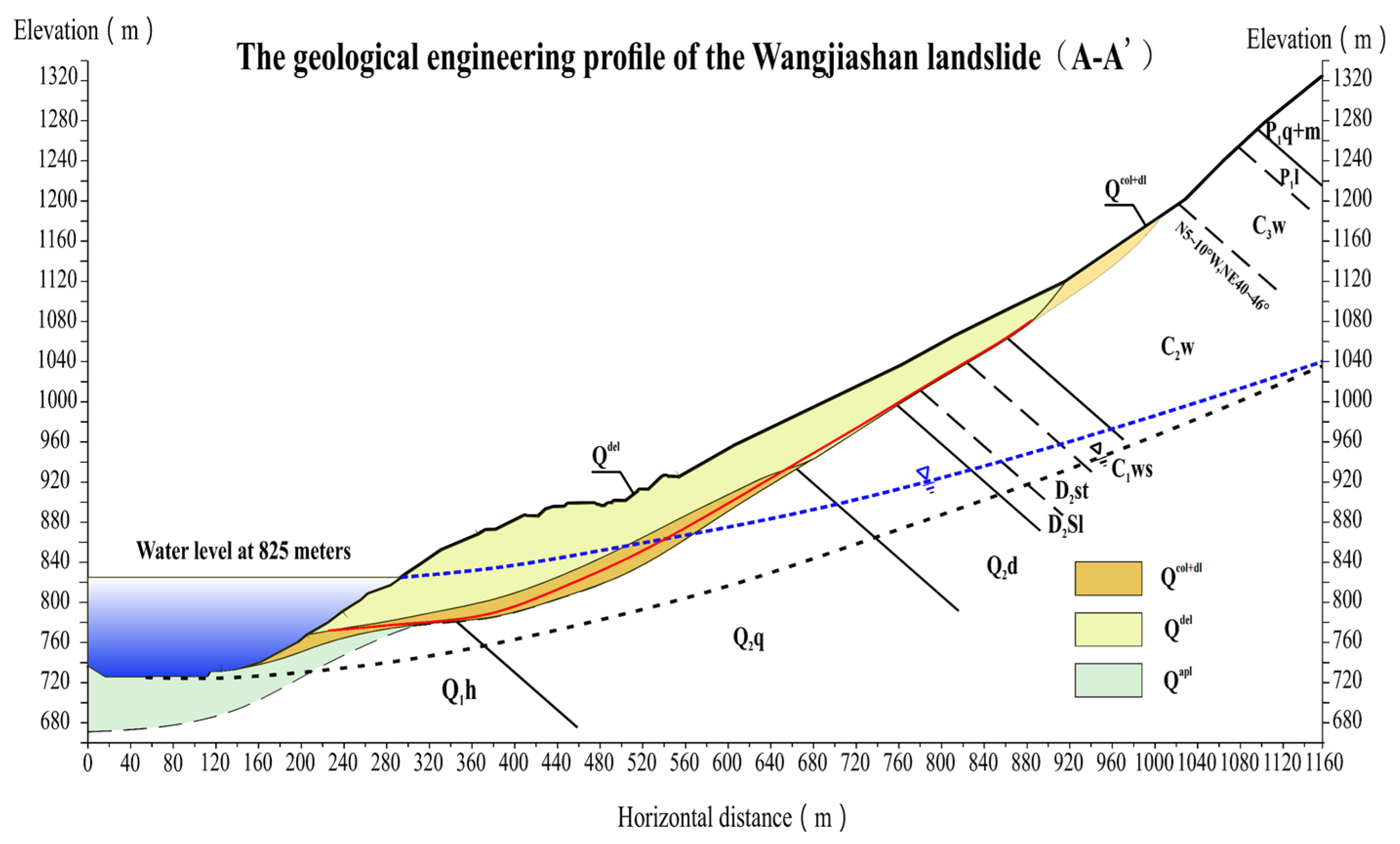

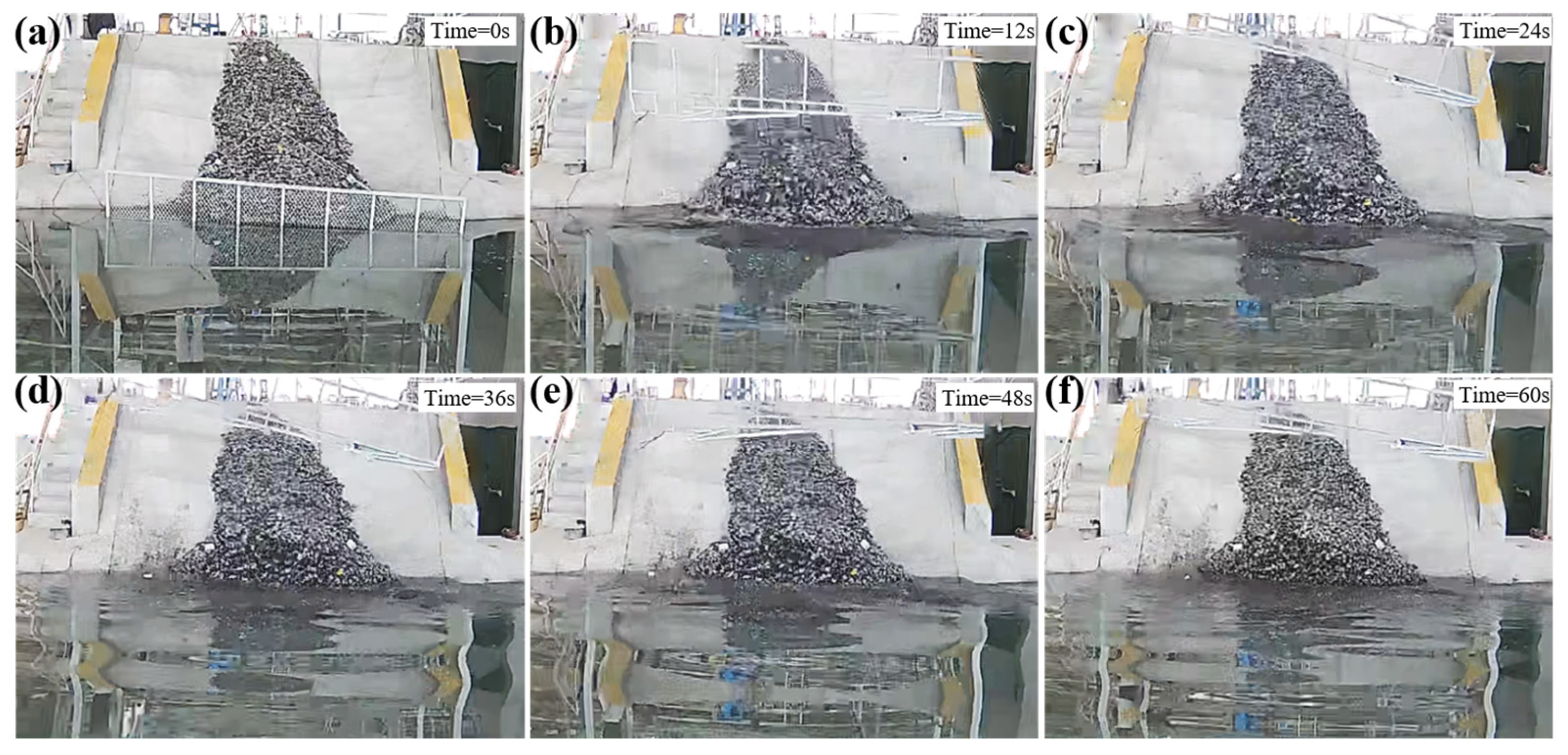
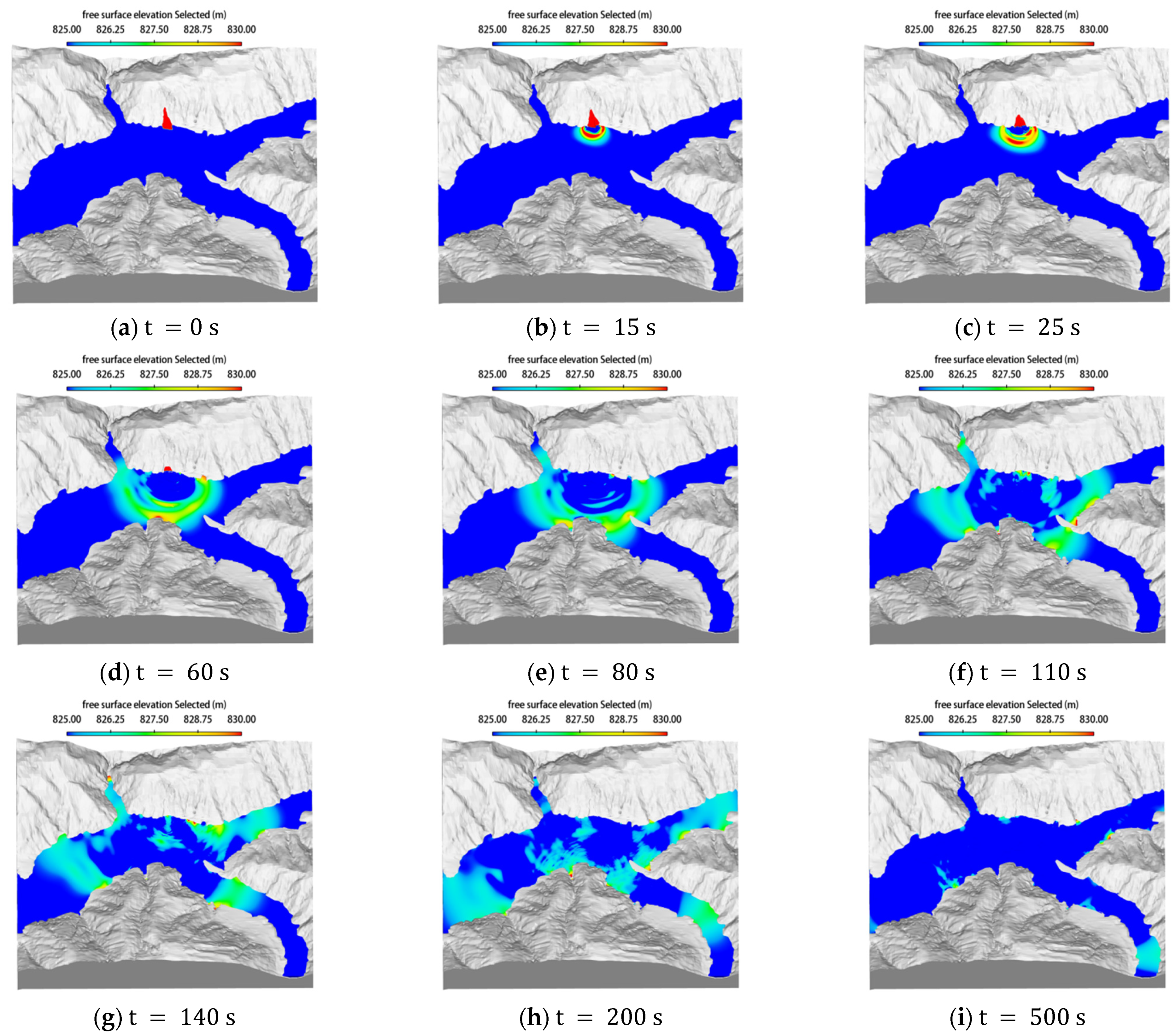

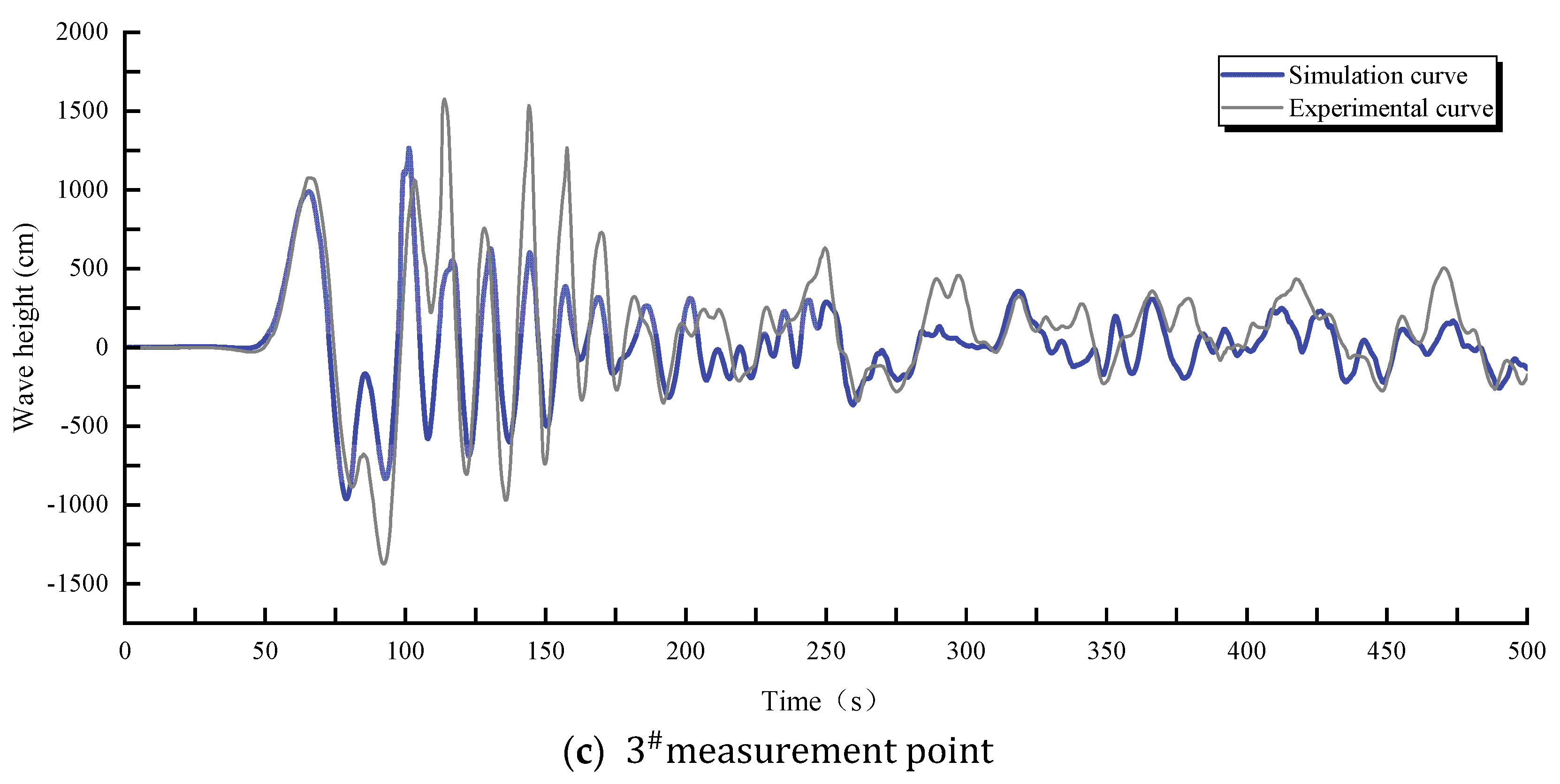

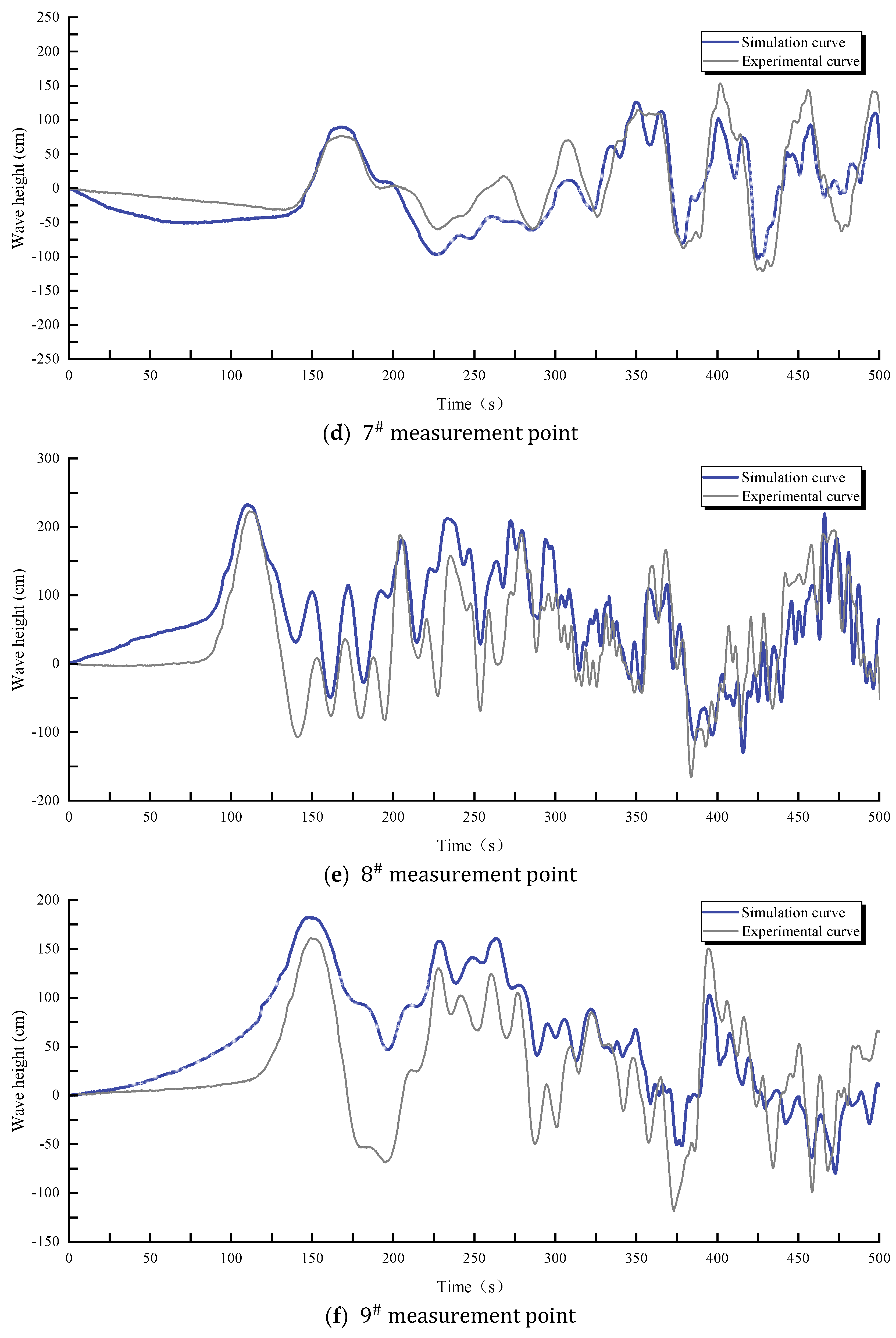
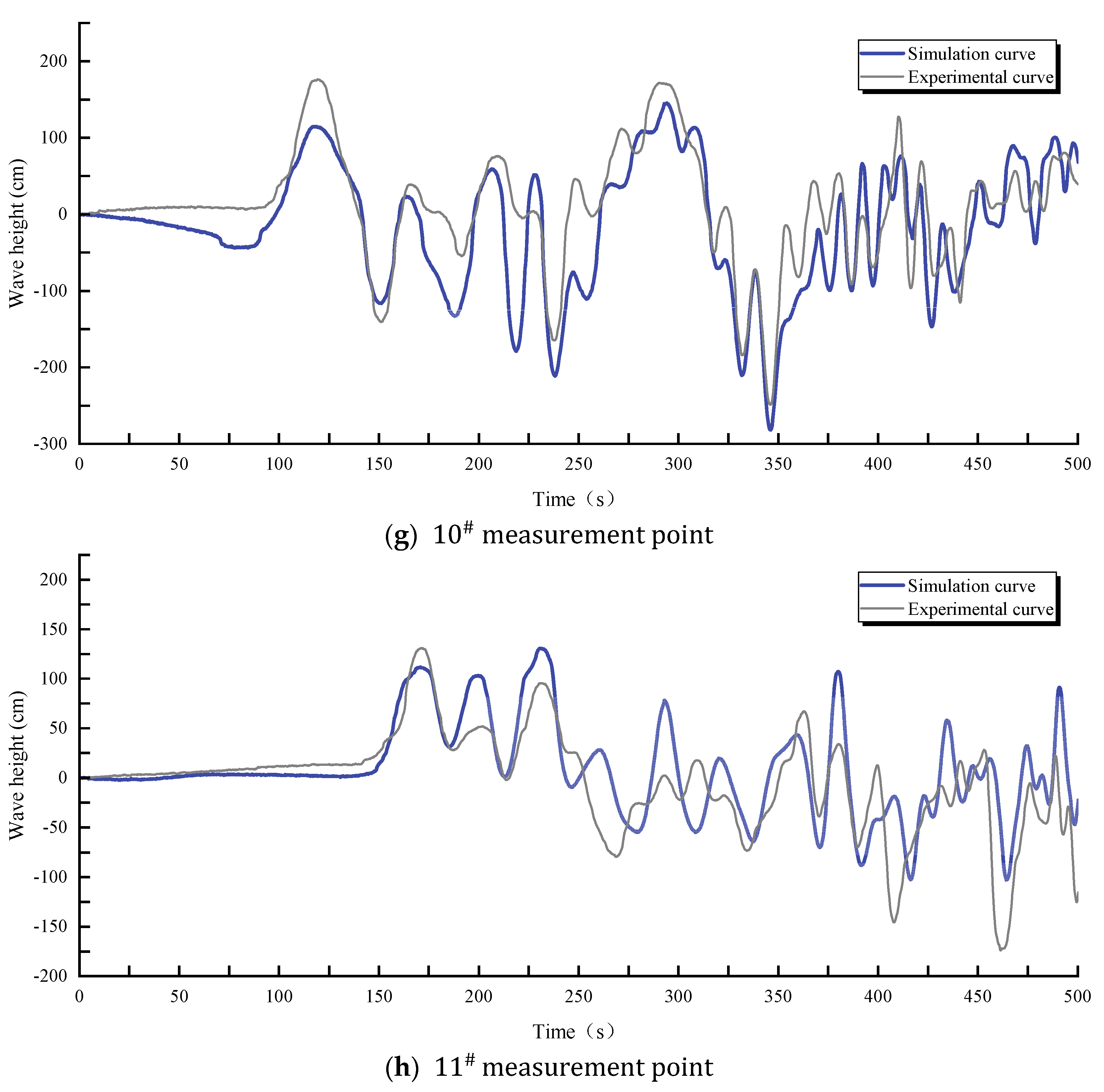
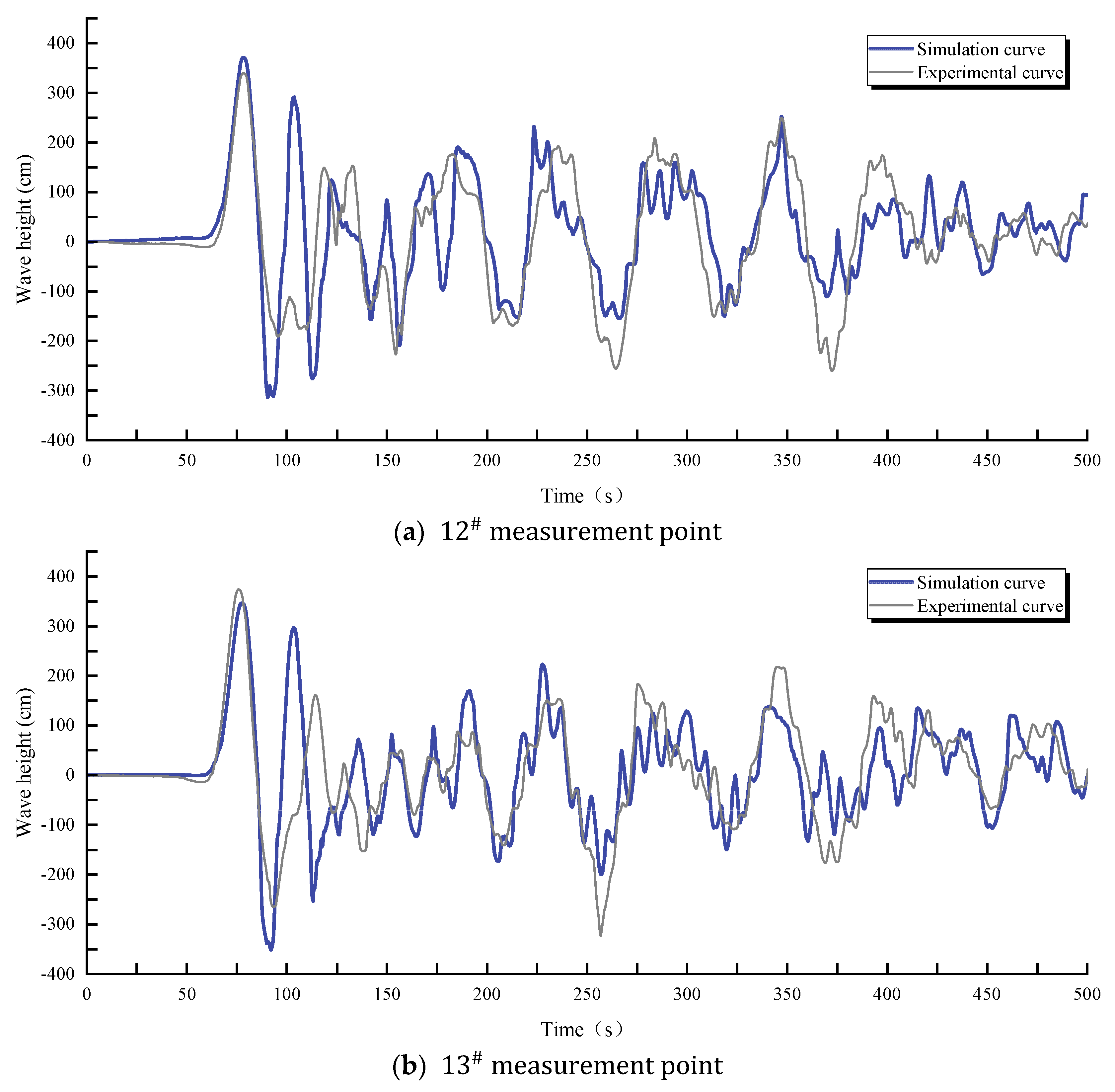

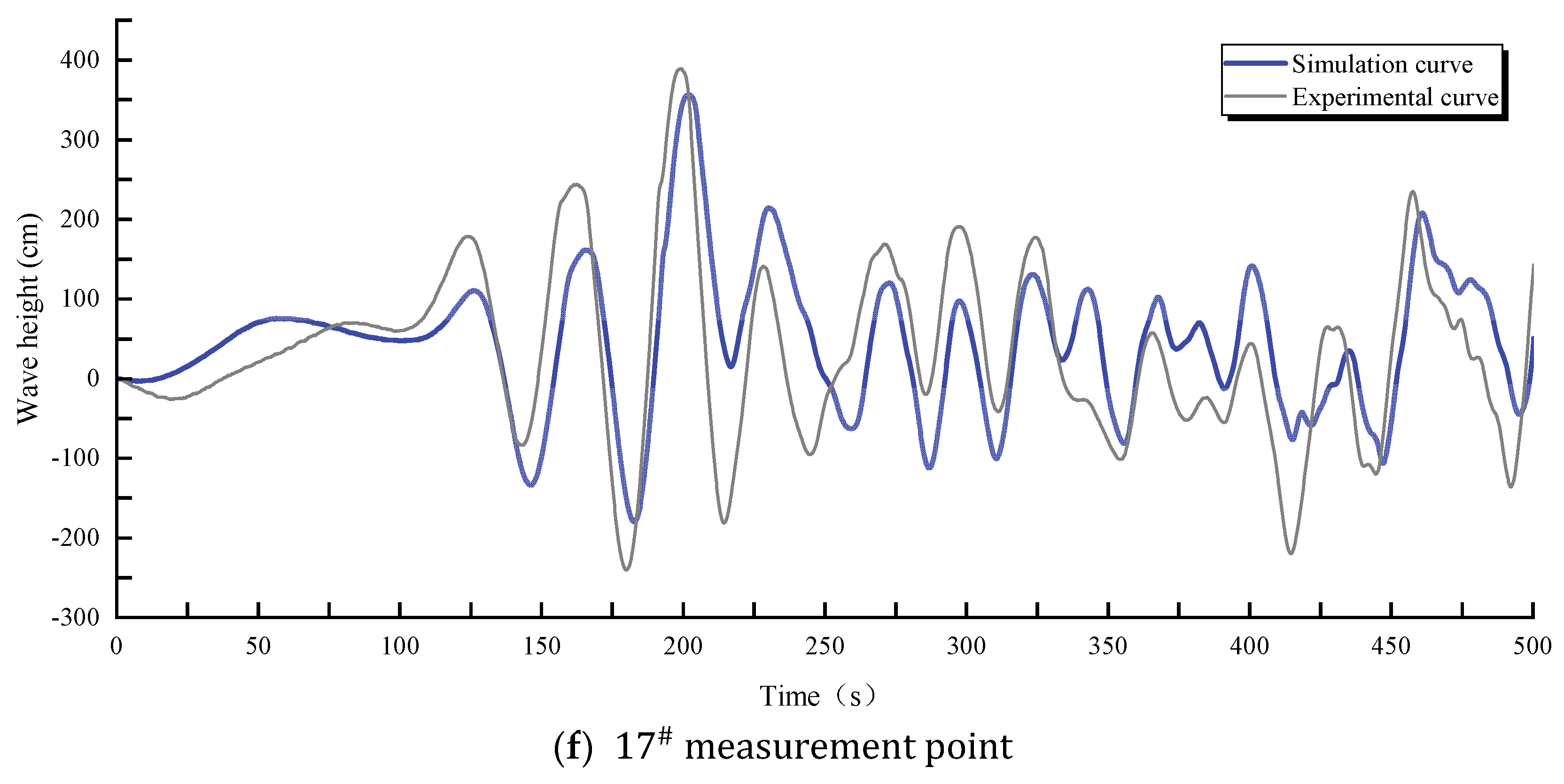

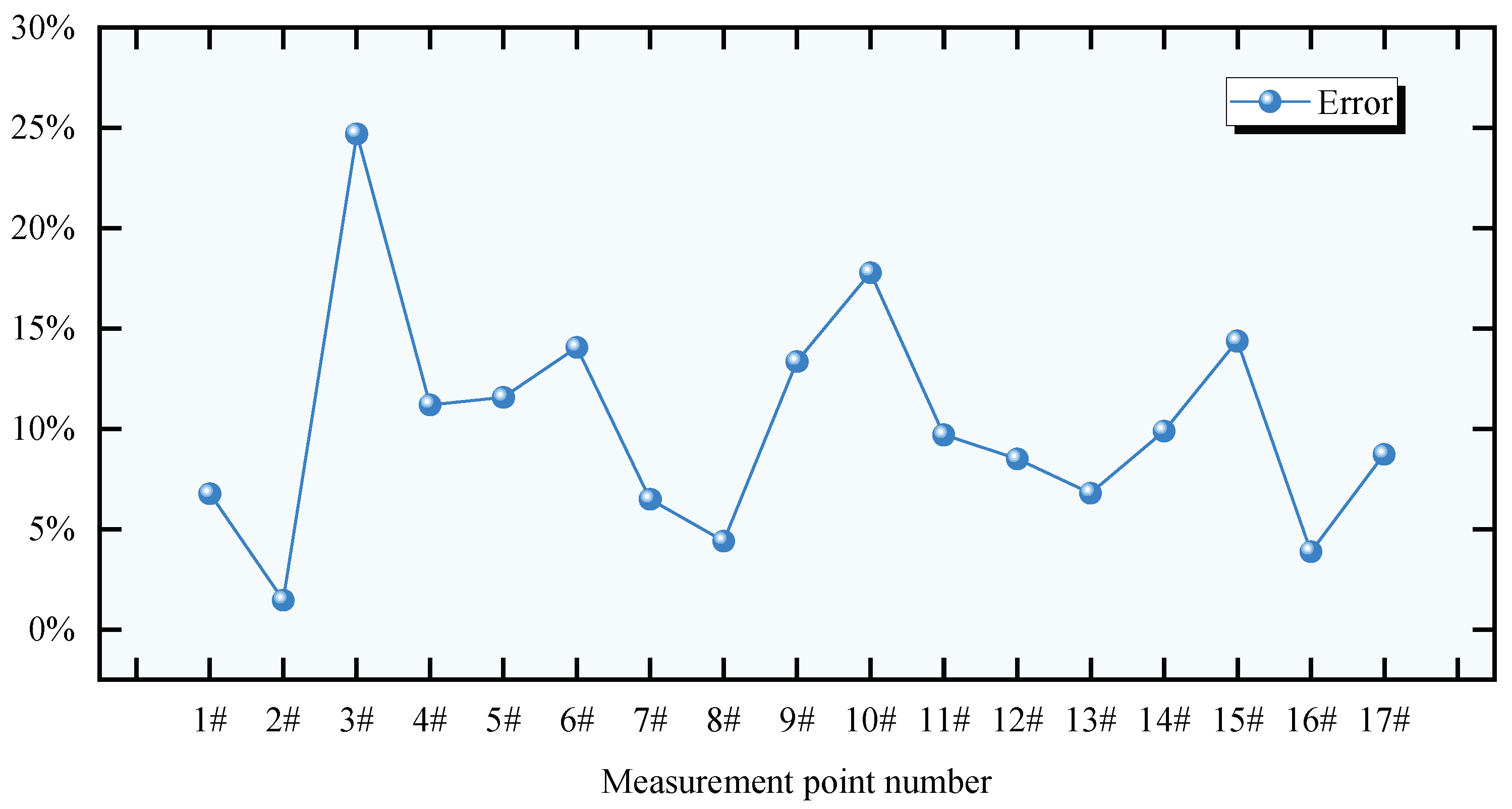
| Classification | Research Methods | Advantages | Limitations |
|---|---|---|---|
| Empirical formulas | Fritz Method | Accurate and stable | Operation is complex |
| E. Noda Method | Efficient and flexible | Overly sensitive | |
| Pan Jiazheng Method | Practical and universal | Results are rough | |
| Slingerland and voight Method | Considers multiple factors, reliable outcomes | Complex calculations, requires extensive data | |
| Water Research Institute Method | Comprehensive and integrated | Time-consuming and labor-intensive | |
| Physical model experiments | Two-dimensional physical model experiment | Simple and intuitive | Highly limited |
| Three-dimensional physical model experiment | Realistic reproduction | High experimental costs, long duration | |
| Numerical simulations | CFD | Precise simulation | Computationally intensive |
| SPH | Strong adaptability | Lacks precision | |
| CFD-DEM, SPH-DEM | Coupled analysis | Long computation time; low efficiency |
| Landslide Name | Scale Ratio | Model Geometry | Landslide Model |
|---|---|---|---|
| Gongjiafang landslide [35] | 1:200 | 24 m × 8 m × 1.3 m | Granular mass |
| Baishuihe landslide [37] | 1:200 | 20 m × 8 m × 1.3 m | Rigid block |
| Stromboli landslide [38] | 1:1000 | 50 m × 30 m × 3 m | Rigid block |
| Jiangnan tuokou landslide | 1:70 | 58 m × 8 m × 1.6 m | Blocks combined |
| Wangjiashan landslide [39] | 1:150 | 30 m × 27 m × 1.5 m | Rigid block |
| Midui ice avalanches [40] | 1:250 | 3.9 m × 2.2 m | Rigid block |
| Measurement Point Number | Arrival Time of the First Wave (s) | Height of the First Wave (cm) | Maximum Wave Height (cm) | Maximum Run-Up Height (cm) | ||||
|---|---|---|---|---|---|---|---|---|
| A | B | A | B | A | B | A | B | |
| H1 | 26.2 | 27.4 | 42.8 | 43.1 | 380.3 | 354.6 | _ | _ |
| H2 | 34.2 | 33.8 | 52.9 | 53.4 | 309.2 | 304.7 | _ | _ |
| H3 | 45.5 | 44.5 | 65.6 | 66.8 | _ | _ | 1264.3 | 1576.6 |
| H4 | 42.1 | 43.8 | 70.3 | 70.8 | 158.1 | 140.4 | _ | _ |
| H5 | 74.7 | 75.4 | 192.9 | 151.5 | 192.9 | 170.6 | _ | _ |
| H6 | 92.8 | 88.9 | 93.2 | 80.1 | 93.2 | 80.1 | _ | _ |
| H7 | 138.8 | 142.5 | 76.6 | 88.9 | 141.9 | 151.1 | _ | _ |
| H8 | 88.2 | 88.4 | 222.4 | 232.2 | 222.4 | 232.2 | _ | _ |
| H9 | 101.1 | 109.3 | 160.4 | 181.8 | 160.4 | 181.8 | _ | _ |
| H10 | 96.3 | 91.7 | 176.6 | 114.6 | 176.6 | 145.2 | _ | _ |
| H11 | 140.8 | 147.9 | 130.6 | 111.2 | 145.4 | 131.3 | _ | _ |
| H12 | 60.1 | 57.5 | 339.8 | 370.6 | _ | _ | 339.8 | 370.6 |
| H13 | 57.8 | 59.8 | 373.7 | 348.3 | _ | _ | 373.7 | 348.3 |
| H14 | 58.2 | 57.3 | 322.4 | 354.3 | _ | _ | 322.4 | 354.3 |
| H15 | 61.4 | 58.1 | 288.7 | 330.2 | _ | _ | 288.7 | 330.2 |
| H16 | 59.2 | 58.8 | 260.2 | 270.3 | _ | _ | 260.2 | 270.3 |
| H17 | 64.1 | 63.2 | 177.1 | 126.1 | _ | _ | 390.6 | 356.5 |
Disclaimer/Publisher’s Note: The statements, opinions and data contained in all publications are solely those of the individual author(s) and contributor(s) and not of MDPI and/or the editor(s). MDPI and/or the editor(s) disclaim responsibility for any injury to people or property resulting from any ideas, methods, instructions or products referred to in the content. |
© 2024 by the authors. Licensee MDPI, Basel, Switzerland. This article is an open access article distributed under the terms and conditions of the Creative Commons Attribution (CC BY) license (https://creativecommons.org/licenses/by/4.0/).
Share and Cite
Shi, A.; Lei, J.; Tian, L.; Lyu, C.; Mao, P.; Xu, W. Benchmarking Physical Model Experiments with Numerical Simulations for the Wangjiashan Landslide-Induced Surge Waves in the Baihetan Reservoir Area. Water 2024, 16, 1930. https://doi.org/10.3390/w16131930
Shi A, Lei J, Tian L, Lyu C, Mao P, Xu W. Benchmarking Physical Model Experiments with Numerical Simulations for the Wangjiashan Landslide-Induced Surge Waves in the Baihetan Reservoir Area. Water. 2024; 16(13):1930. https://doi.org/10.3390/w16131930
Chicago/Turabian StyleShi, Anchi, Jie Lei, Lei Tian, Changhao Lyu, Pengchao Mao, and Weiya Xu. 2024. "Benchmarking Physical Model Experiments with Numerical Simulations for the Wangjiashan Landslide-Induced Surge Waves in the Baihetan Reservoir Area" Water 16, no. 13: 1930. https://doi.org/10.3390/w16131930





